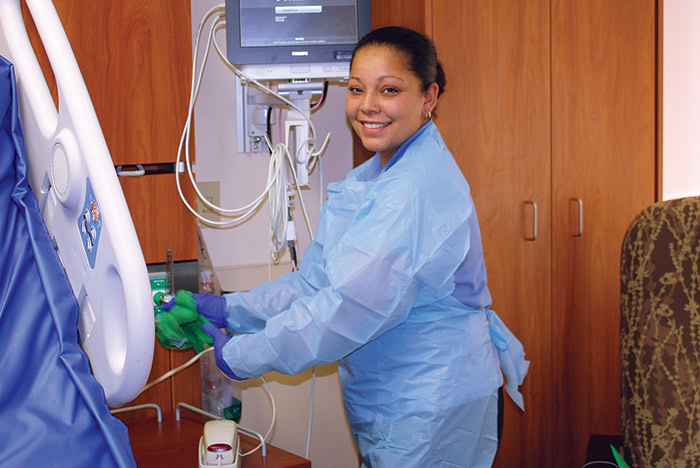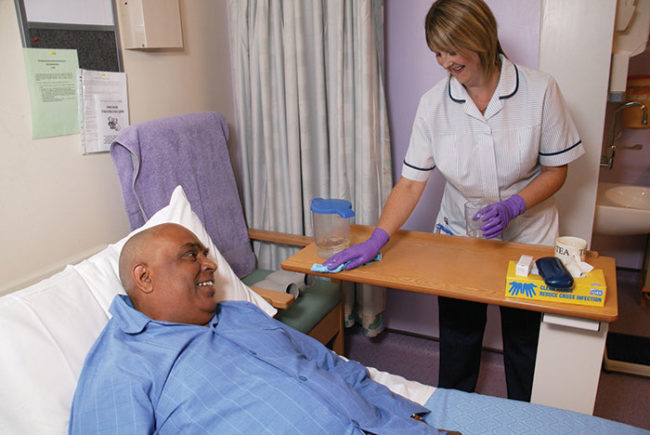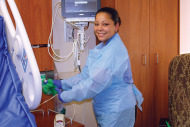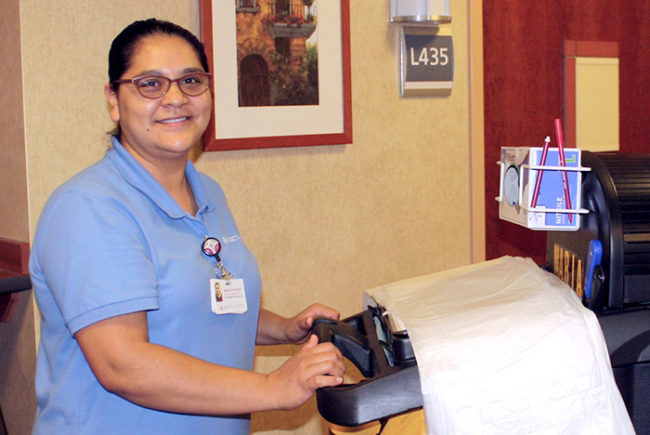
Staff members in high-performing organizations are expected to smile and interact with individuals with whom they cross paths.
Everything the environmental services department does impacts all customers within a health care organization in one form or another — patients, visitors and colleagues.
A positive customer service program starts with quality, and customers should perceive that quality as they enter the front door of the organization and continue through the entire facility.
How environmental services professionals do their jobs can affect a health care organization's HCAHPS scores. Consequently, customer service is vitally important and necessary for an environmental services leader to monitor and implement.
A positive environment
Providing a positive customer experience should be a top priority for any environmental services leader. This can be accomplished at the highest levels as well as with front-line colleagues.
Also in this article |
| Creating a positive environment throughout the entire hospital |
|
|
Daily scripting is a starting point. This includes having the environmental services staff member ask permission to enter the patient’s room; entering the room with a calming presence and smiling; greeting the patient by name; introducing himself or herself and explaining his or her role in patient care; asking if assistance is needed and informing nursing if it is something they need to perform; escorting a patient or visitor to a desired location, if time allows; reporting any comments or concerns to related departments for immediate attention; performing all duties in a professional, detailed way; engaging in meaningful conversation; reviewing the work and inspecting the room for any concerns; and creating positive resolutions to any observed opportunities.
How the environmental services staff interacts with visitors, vendors and contractors when they see them in the hallways often can be just as important as the patients. In high-performing health care organizations, staff members are expected to smile and interact with individuals with whom they cross paths. This permeates the organization in such a way that it becomes a part of the culture.
The patient experience
The patient experience is shaped by past experiences, which may evoke fear, frustration, anxiety or excitement. The environmental services department’s goal is to embrace the patient or visitor, reduce anxiety, eliminate frustration and define a better experience that exceeds expectations. Environmental services, facilities, support services and the clinical staff are an integral team whose goal is to define the experience and make it as positive as possible.
When analyzing the patient experience, all aspects of the patient engagement must be evaluated, starting with the physical exterior. As the client enters the campus, what perception is formed? Are the grounds manicured and free of debris? Does landscaping invite a feeling of serenity? Is the entrance positively presented?
You may also like |
| 2016 ES Department of the Year |
| ES and customer service |
| Improving ES customer service |
|
|
For example, Mercy Health Saint Mary’s, Grand Rapids, Mich., has a cathedral a short distance away. Because it is a Catholic hospital, it has dedicated resources to identify with the cathedral. This is seen in the walkway from the cathedral to the hospital’s main entrance. Work is underway to move this connection down the hospital’s main corridor to its “Mind, Body and Spirit” suite and also to its cafeteria to display wellness in a multifaceted way.
Additionally, it should be on the environmental services leader’s mind that entrances and exits are focal points and should be monitored routinely to remain clean and free of debris.
Moving further into the facility, a patient will notice whether the windows are clean. Are horizontal surfaces dust-free? Are the elevators clean? Are directions clear as the patient, visitor or staff person navigates throughout the facility? Cleanliness is evaluated at every point of interaction. Is the patient transporter friendly as the patient is moved to and from the radiology department? Presentation is vital to a patient’s perception and customer satisfaction is based on perception.
Once checked in, the patient observes other things. Did the dietary aide knock before entering the room? Does the transporter steer safely and engage in conversation? Does the environmental services technician have a badge that clearly displays his or her name? Does he or she explain his or her role in providing a clean and safe environment? Was the patient greeted by name?
Another move to improve the patient experience is having front-line staff notify the environmental services department leader when they have cleaned a room if the patient or resident was sleeping or out for testing. The leader then can notify the second-shift leader who visits the patient or family to see if the room was cleaned as expected, stating that the patient was sleeping or out of the room during the normal daily cleaning procedure.
A systematic approach of seeking continuous improvement allows the facility to exceed expectations of patients consistently. The environment and the culture of the facility can influence behaviors that will determine patient perceptions which, in turn, should align with the organization’s culture. Environmental services colleagues can be the ones to define the expectation and strive to exceed it in delivery and execution with each interaction.
Building relationships
Improving customer service must progress seamlessly from the C-suite through middle management to front-line employees. A clear and consistent message exemplified in the actions of all leaders is vital to sustaining the culture of the organization. Educating environmental services colleagues to understand the desired impact encourages them to internalize the behavior. An organized and systemic approach is formed as colleagues emulate the behavior.
Customer satisfaction is based on building better relationships through each opportunity for engagement. Interactions with colleagues, patients, vendors and multiple departments are critical to building an infrastructure that creates bonds and reinforces the “wow!” experience. Environmental colleagues should exemplify the organization’s culture. Strong relationships with internal and external customers also will build strong relationships within the community.
Building relationships is the overarching component of customer service excellence. When a facility is being cleaned, environmental services staff can fully engage internal and external customers. It is critical that they perform their duties efficiently. Technically, the environmental services staff members often spend more time in the patient room than any other team member.
If environmental services leaders operate under the premise that the patient is a guest in their workplace and that he or she is not feeling well, department personnel will approach their tasks in a quiet and efficient manner to minimize disruption to the patient. The patient appreciates a quiet entry, a calming presence, a coordinated outline of tasks and a prompt exit. Environmental colleagues should be encouraged to foster a quiet environment for healing. Compassionate communication with respectful presentation and a positive attitude will demonstrate customer service excellence to the patient.
Colleagues throughout the organization should be hired to maintain the culture and be educated with the essentials to motivate performance. The right staff members will elevate the patient experience by modeling positive behaviors.
Gathering feedback
Another, often overlooked, aspect of customer service is the visibility of environmental services leadership. One action is to have each leader visit the floors to talk with staff as well as nursing staff. The next level is visiting with patients or their family members. This is a largely proactive move for the leadership, but also is vitally important.
Another way of receiving feedback is by leaving tent cards in each room. These cards usually have on one side what the environmental services department does on a daily basis and an area with contact information for the department, if further service is needed. An area also is provided for the staff member to sign off on. Provide these tent cards after each daily cleaning and at discharge or terminal cleaning. Another way to receive feedback is to install signage in every public restroom informing who to call if it is not clean.
Additionally, formal and informal customer feedback can be obtained through phone calls and email; routine monitoring of the facility as outlined in the department’s quality assurance program; either phone or in-person contact with each medical center department manager on at least a quarterly basis to discuss the service delivery as well as satisfaction, suggestions for improvement and areas of strength; casual conversations, initiated with various customers on a random basis, to confirm satisfaction with service delivery or identify opportunities for improvement; using Survey Monkey's online survey software; and, of course, through the HCAHPS website.
Excellence at its best
Environmental services leaders and staff can provide a link to the necessary resources for the patient. They can assist by offering to make a call, inform the nurse of a dietary request or report a need to plant operations. As department employees build a relationship with the patient, he or she becomes more comfortable communicating with staff and may share information that requires intervention by another department. Follow-up ensures that the need was addressed.
As patients, visitors or family members engage with the staff, the ultimate goal is to achieve positive experiences. Positive body language and effective communication at all levels are important. Patients remember positive interactions more than they remember names. A positive resolution to all concerns should be the goal of every health care organization.
Environmental services staff should be empowered to connect with patients. They should feel motivated so that every interaction creates a positive patient experience. Allow staff who are ingrained in the culture to develop creative ways within the organizational framework to create innovations that foster patient satisfaction. This interaction brings fulfillment to the colleague, gives comfort to the patient and reinforces the positive culture of the facility.
Kent L. Miller, CHESP, T-CHEST, is director of environmental services, Mercy Health Saint Mary's, Grand Rapids, Mich. He can be reached at kent.miller@mercyhealth.com.





